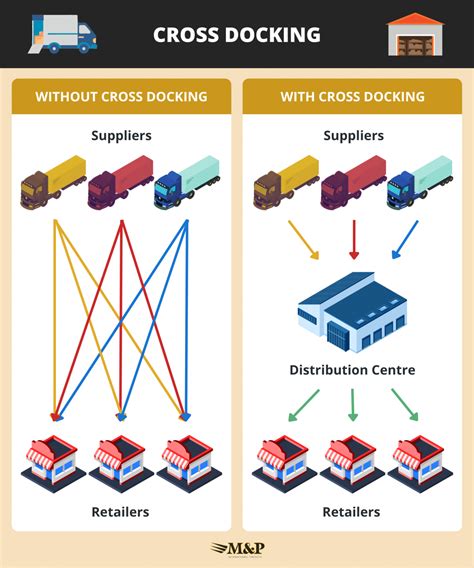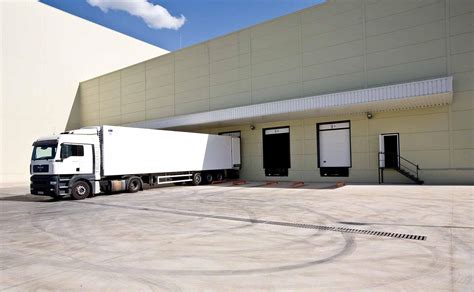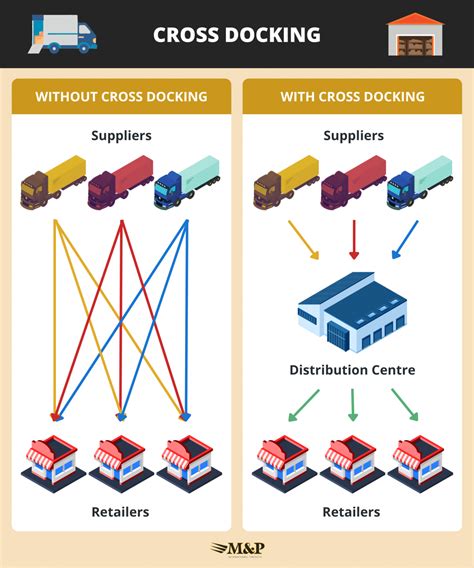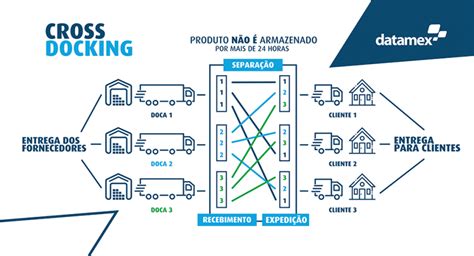In the ever-evolving world of logistics and supply chain management, the concept of cross-docking has emerged as a strategic tool to enhance efficiency and reduce costs. This innovative approach, when integrated with a well-designed warehouse system, can revolutionize the way goods are handled and distributed.
This article aims to delve into the intricacies of cross-docking, exploring its benefits, challenges, and real-world applications. By examining the symbiotic relationship between cross-docking and warehouse systems, we can uncover the potential for optimizing supply chains and improving overall operational performance.
Understanding Cross-Docking: A Strategic Approach

Cross-docking is a logistical strategy that involves the immediate distribution of incoming goods to outgoing transportation, with minimal to no storage time. Unlike traditional warehousing, where products are stored for an extended period before being shipped, cross-docking aims to streamline the flow of goods, reducing handling and storage costs.
The concept of cross-docking has its roots in the early 20th century, with some of the first implementations seen in the United States during World War II. However, it gained prominence in the 1980s as a response to the growing demand for just-in-time delivery systems. The idea was simple: eliminate the need for extensive storage by moving goods directly from one mode of transportation to another, hence the term "cross-docking."
The core principle of cross-docking is to create a seamless flow of goods, where products arrive at a distribution center and are immediately sorted, consolidated, and dispatched to their final destinations. This process relies on precise coordination and efficient workflows to ensure that goods are delivered to the right place at the right time.
Benefits of Cross-Docking
- Reduced Storage Costs: By minimizing the need for long-term storage, cross-docking significantly lowers warehousing expenses. This is particularly beneficial for businesses dealing with perishable goods or those operating in industries with high inventory turnover rates.
- Improved Cash Flow: With reduced storage times, businesses can free up cash that would otherwise be tied up in inventory. This improved cash flow can be reinvested into other areas of the business, such as research and development or marketing initiatives.
- Enhanced Customer Service: Cross-docking allows for faster delivery times, as goods are shipped directly to customers or retailers without the delay of traditional warehousing. This can lead to increased customer satisfaction and loyalty, as well as a competitive edge in the market.
- Efficient Use of Resources: By optimizing the flow of goods, cross-docking reduces the need for excessive labor and equipment. This not only saves costs but also leads to a more sustainable and environmentally friendly logistics operation.
Despite its numerous advantages, cross-docking is not without its challenges. One of the primary concerns is the need for precise coordination and planning. The success of cross-docking relies heavily on accurate forecasting, efficient communication between supply chain partners, and a well-designed warehouse system.
The Role of Warehouse Systems in Cross-Docking

A well-designed warehouse system is the backbone of a successful cross-docking operation. It provides the necessary infrastructure and technology to support the seamless flow of goods, ensuring that products are received, sorted, and dispatched with maximum efficiency.
Key Components of a Warehouse System for Cross-Docking
- Receiving and Docking Areas: These areas are designed to accommodate the efficient unloading and inspection of incoming goods. They should be equipped with adequate space, docking stations, and material handling equipment to facilitate the rapid transfer of products.
- Sortation and Consolidation Zones: Here, products are sorted based on their destination and consolidated into outbound loads. These zones require a well-organized layout, efficient conveyor systems, and a robust warehouse management system to ensure accurate sorting and consolidation.
- Outbound Shipping Areas: The outbound shipping areas are where goods are loaded onto outbound transportation. These areas should be designed to maximize loading efficiency, with adequate space for various modes of transportation and the necessary equipment to secure loads.
- Technology Integration: A modern warehouse system for cross-docking relies heavily on technology. This includes warehouse management systems (WMS), barcode scanning, and real-time tracking systems to ensure accurate inventory management and efficient order fulfillment.
| Warehouse System Component | Real-World Example |
|---|---|
| Automated Sortation System | A large distribution center utilizes a high-speed conveyor system with automated sorters to route packages to their designated outbound lanes, ensuring efficient sorting and minimizing handling time. |
| Real-Time Inventory Management | A warehouse employs a WMS integrated with RFID technology, allowing for real-time tracking of inventory levels and locations, ensuring accurate order fulfillment and minimizing stockouts. |
| Dock Management Software | A cross-docking facility uses dock management software to optimize dock utilization, schedule inbound and outbound deliveries, and provide real-time visibility to supply chain partners, improving overall operational efficiency. |

Real-World Applications and Success Stories
The effectiveness of cross-docking and its integration with warehouse systems can be seen in various industries and businesses around the world.
Retail and E-commerce
In the highly competitive retail and e-commerce sectors, cross-docking has become a strategic tool to meet customer demands for fast and efficient delivery. Retailers like Amazon and Walmart have embraced cross-docking to streamline their supply chains and reduce delivery times. By utilizing well-designed warehouse systems, these companies can process a high volume of orders with minimal storage requirements, ensuring a seamless customer experience.
Food and Beverage Industry
The food and beverage industry, particularly in the case of perishable goods, benefits significantly from cross-docking. Companies like Sysco and US Foods utilize cross-docking to ensure that fresh produce and other perishable items reach their destinations quickly, minimizing the risk of spoilage and maximizing product quality.
Automotive Industry
The automotive industry often relies on just-in-time delivery systems, making cross-docking an ideal solution. Manufacturers and suppliers use cross-docking to ensure that parts and components arrive at assembly plants as needed, reducing inventory carrying costs and optimizing production schedules.
Challenges and Considerations
While cross-docking offers numerous benefits, it is not without its challenges. Some of the key considerations include:
- Forecasting Accuracy: Accurate demand forecasting is crucial for successful cross-docking. Inaccurate forecasts can lead to stockouts or excess inventory, both of which can impact operational efficiency and customer satisfaction.
- Supply Chain Collaboration: Cross-docking relies on effective collaboration between supply chain partners. This includes timely communication, efficient information sharing, and a shared commitment to just-in-time delivery.
- Product Compatibility: Not all products are suitable for cross-docking. Factors such as size, weight, and fragility need to be considered to ensure that the products can be handled and transported efficiently without damage.
- Regulatory Compliance: Depending on the industry and the nature of the goods, cross-docking operations may need to comply with specific regulations and standards. This can add complexity to the process and require additional training and documentation.
Future Implications and Trends

As supply chain management continues to evolve, cross-docking is likely to play an even more significant role. The following trends and developments are shaping the future of cross-docking and warehouse systems:
- Automation and Robotics: The integration of automation and robotics in warehouse systems is expected to enhance the efficiency and accuracy of cross-docking operations. Automated guided vehicles (AGVs) and robotic sorters can further reduce handling time and improve overall productivity.
- Data Analytics and AI: Advanced data analytics and artificial intelligence (AI) are being utilized to optimize cross-docking processes. These technologies can analyze vast amounts of data to predict demand, optimize routing, and improve overall supply chain visibility.
- Sustainable Practices: With a growing focus on sustainability, cross-docking and warehouse systems are expected to adopt more eco-friendly practices. This includes the use of energy-efficient equipment, waste reduction strategies, and the adoption of renewable energy sources.
- Last-Mile Delivery Innovations: As the final leg of the supply chain, last-mile delivery is a critical aspect of cross-docking. Innovations such as drone delivery, electric vehicles, and crowdshipping are likely to reshape the way goods are delivered to the end customer, further enhancing the efficiency of cross-docking operations.
Conclusion
Cross-docking, when integrated with a well-designed warehouse system, offers a powerful solution for businesses aiming to optimize their supply chains. By minimizing storage time and maximizing the efficiency of goods distribution, cross-docking can lead to significant cost savings, improved customer service, and a more sustainable logistics operation.
As the logistics industry continues to evolve, the strategic implementation of cross-docking and innovative warehouse systems will be pivotal in meeting the demands of a fast-paced, customer-centric market. With a focus on technology, collaboration, and sustainability, businesses can leverage cross-docking to gain a competitive edge and drive success in an increasingly complex global marketplace.
What is the primary advantage of cross-docking over traditional warehousing?
+Cross-docking minimizes storage time and costs by directly distributing goods from inbound to outbound transportation. This results in reduced inventory carrying costs, improved cash flow, and faster delivery times, ultimately enhancing customer satisfaction and operational efficiency.
How does a warehouse system support cross-docking operations?
+A well-designed warehouse system provides the necessary infrastructure and technology to facilitate the seamless flow of goods in a cross-docking operation. This includes receiving and docking areas, sortation and consolidation zones, outbound shipping areas, and the integration of technology such as WMS and barcode scanning for efficient inventory management.
What industries can benefit the most from cross-docking and warehouse systems?
+Cross-docking and warehouse systems are particularly beneficial for industries with high inventory turnover rates, perishable goods, or just-in-time delivery requirements. This includes retail and e-commerce, food and beverage, automotive, and other industries where fast and efficient delivery is critical to success.
